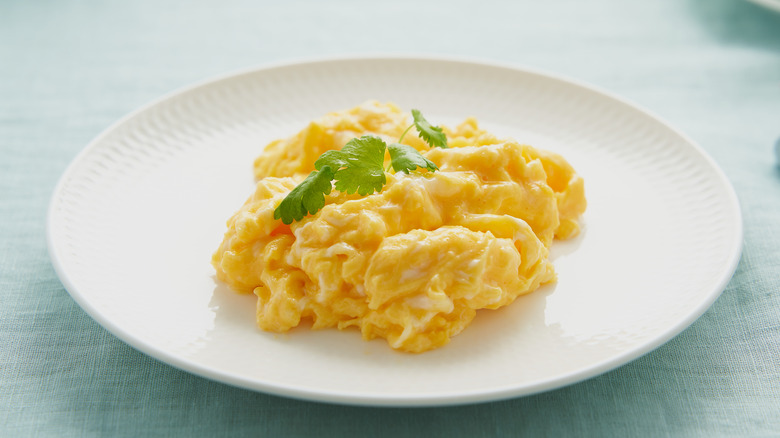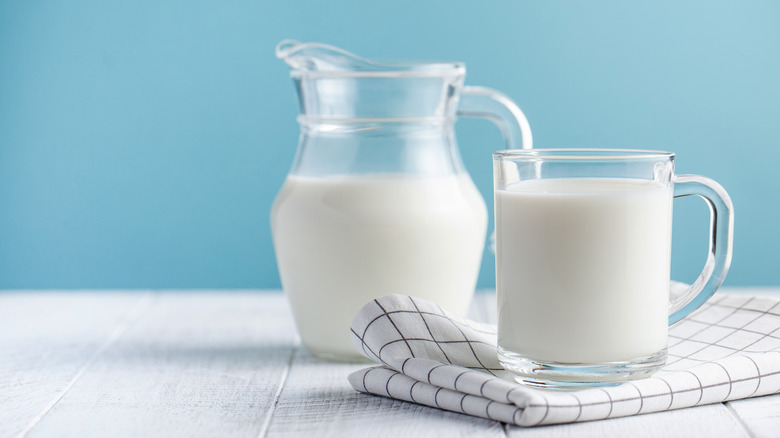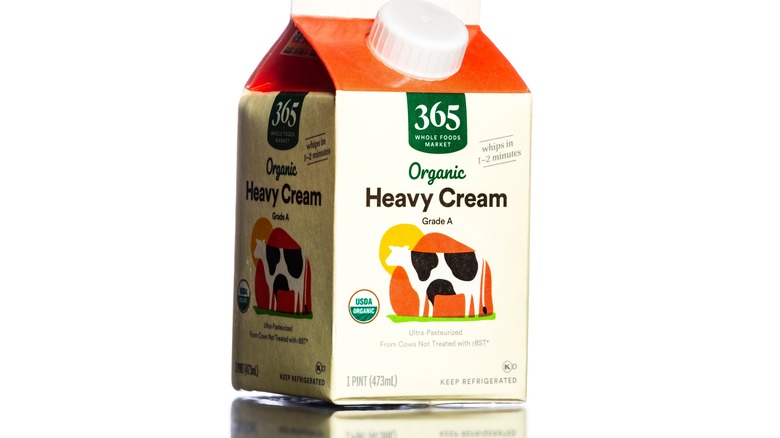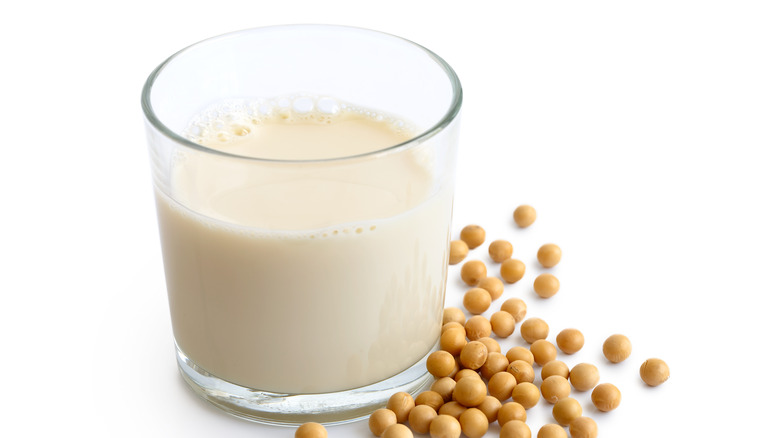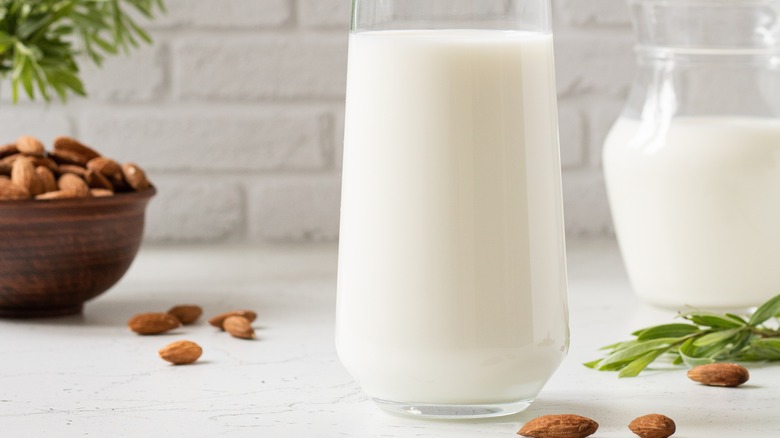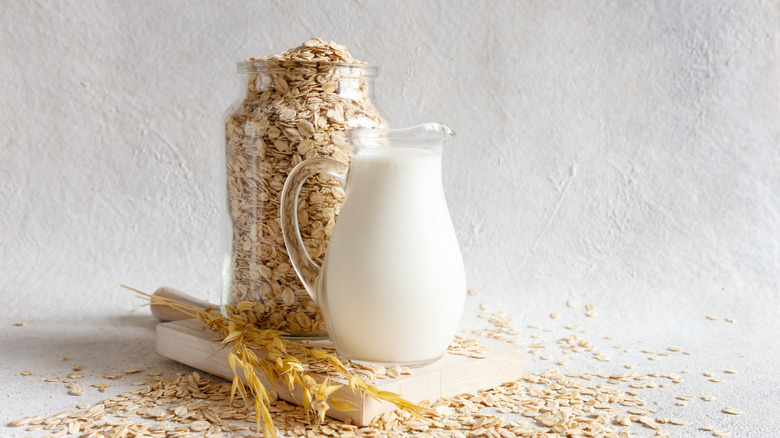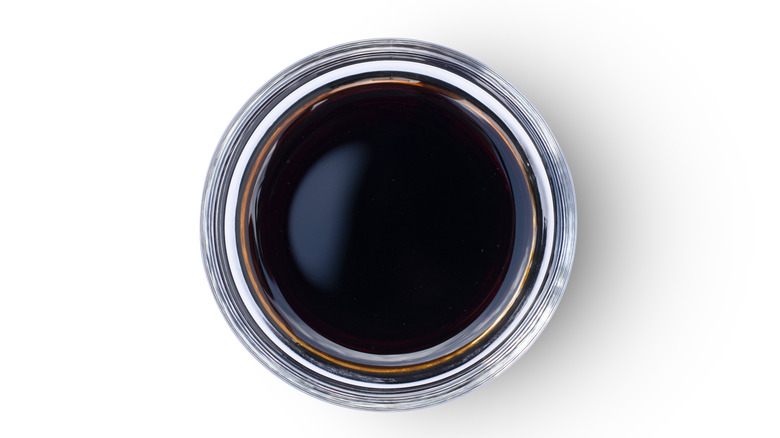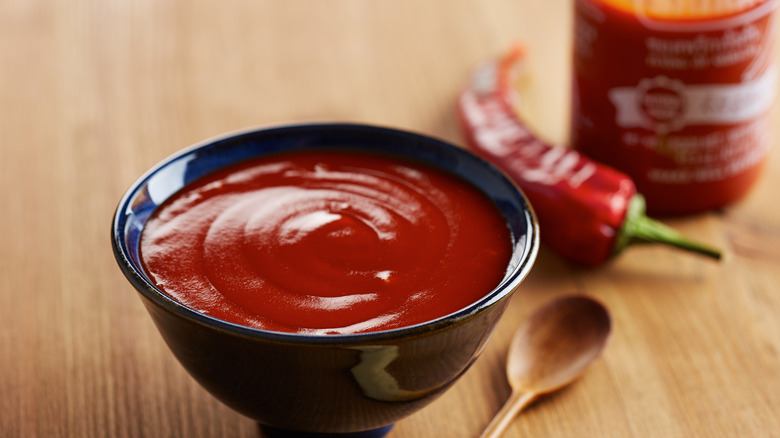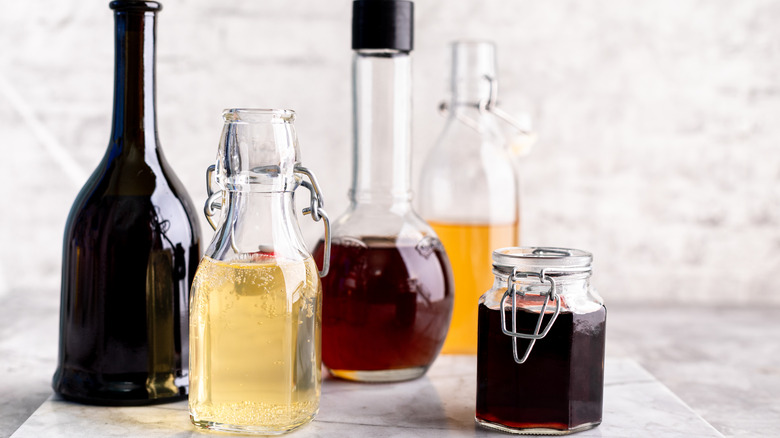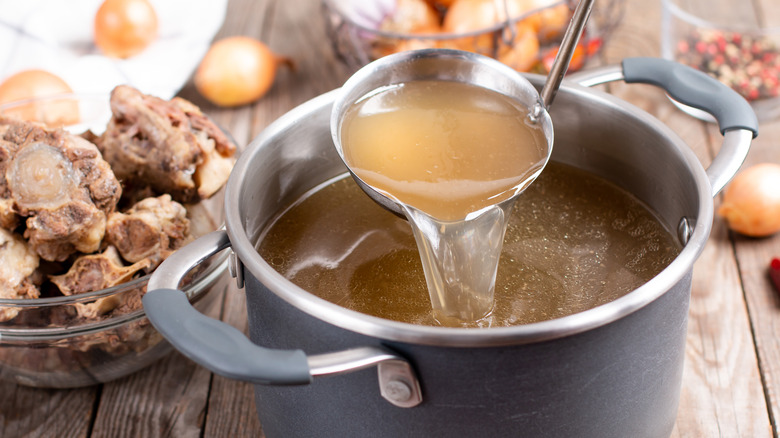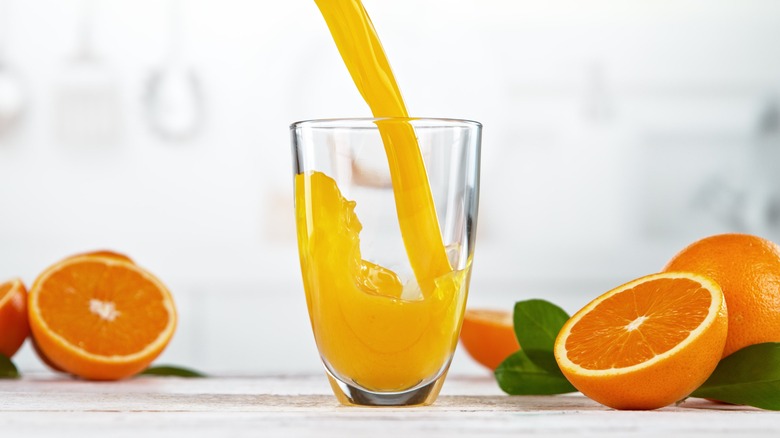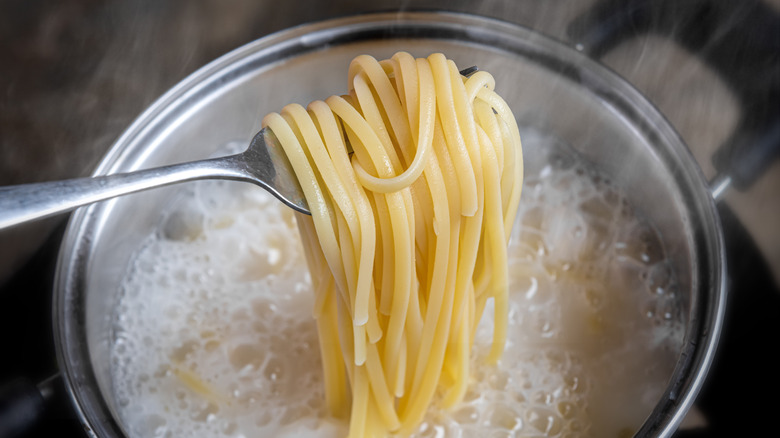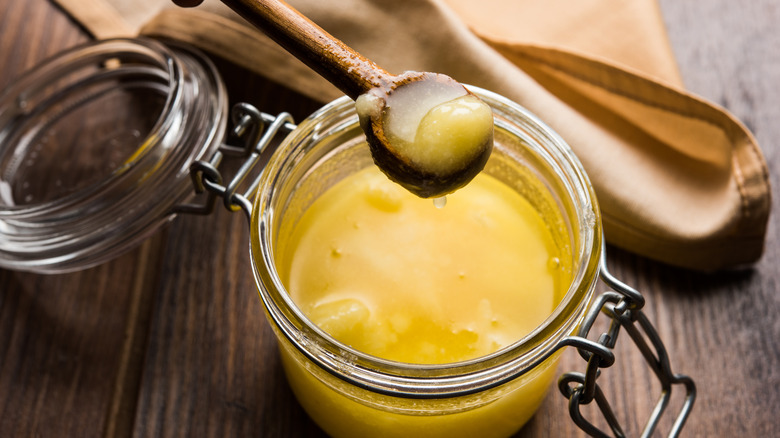14 Liquids To Add To Scrambled Eggs (And What They Do)
We may receive a commission on purchases made from links.
With the rising price of eggs these days, you may be looking for ways to conserve. But for some, swapping out eggs for a chia or flax egg just doesn't cut it, especially if you are in the mood for scrambled eggs. (And not everyone is a fan of a tofu scramble.)
There are some great reasons to enjoy the "incredible edible egg." At just 80 calories, one medium egg contains 6 grams of protein, nearly 3 grams of unsaturated fats, and a wealth of vitamins and minerals including health-sustaining essentials: B vitamins, calcium, iron, magnesium, and vitamins A, D, E, and K (via a 2018 review in Cholesterol). Hence, the egg is a nutrient-dense capsule you can hold in one hand. And it is a convenient protein to cook.
Scrambling eggs can be done in less than 5 minutes. What's more, the simple act of adding a bit of liquid can elevate its appeal. Adding liquids such as water can amplify the volume, so you may be able to use a little less (eggs) in your scramble and still feel you've gotten plenty of mouthfuls. Dairy or cream can provide a creamy and smooth texture to your scramble (rarely does one praise a batch of dry scrambled eggs). And some liquids, like soy sauce, can simply make it taste great!
1. Water
Using water is one of the simplest ways to elevate your scrambled eggs. It's a readily-available resource we all have in our kitchens. So, if you are out of milk, half-n-half, or any of your preferred liquid staples, you can always just use water.
According to Patricia S. York for Southern Living, water is the only additional ingredient you need for a good egg scramble. When you add a splash of water to the mix, it will create steam, which leads to a moist, fluffy, and more voluminous scramble. The rest comes down to how you prepare them, and proper whisking is important, according to York. Whisking vigorously (in a separate bowl before heating on the stove) will incorporate air to help fluff your eggs. And heating it slowly at a low temperature will reap the best results. That's because heating over high temperatures for too long can make your eggs dry and rubbery.
2. Milk
A source of protein, calcium, and vitamin D, milk is a great way to get in both that important macronutrient (protein) and micronutrients like essential vitamins and minerals. So, if milk is one of your staples, adding a splash into your scrambled eggs can add a bit of creaminess, although, the jury is still out on this one. Milk may not be your ideal option as it may make your scrambled eggs firmer. That said, it can still add some moisture, provided you don't use too much or overcook those eggs.
If you are concerned about milk muting the eggs' yellow or golden color, you can add a bit of turmeric or annatto to liven it up. But other than a slight color change, a bit of milk shouldn't detract from its taste. In fact, if you are planning on adding a little heat or a spicy edge to your eggs, the addition of dairy can help temper the burn. That's because the casein in milk can attract and surround those heat-inducing capsaicin molecules that float in your mouth and wash some of those oily compounds away (via Houston Methodist Leading Medicine).
3. Cream
If you want your scramble creamy and rich, a bit of heavy cream can go a long way. With 36% fat, it's calorically rich, but that also means you won't need to use much to satisfy your indulgence. And, besides, you need no more than a tablespoon to make it creamy and dreamy.
Nutritionally, it is similar to whipping cream, but heavy cream is more versatile. According to Real Simple, per tablespoon, heavy cream contains 50 calories and 5 grams of fat (mostly saturated fats); whipping cream is slightly lighter on both accounts (45 calories and 4.5 grams fat). And this does make a difference. Whipping cream is more airy and better suited for garnishing desserts or dolloping onto sweet berries, while heavy cream can be more interchangeable for uses in casseroles, egg dishes, and desserts. So, be sure to read the label and select the right type of cream for your scrambled eggs.
4. Half-and-half
You may not trust yourself to keep a container of heavy cream in your fridge. It's so pleasurable (and as we mentioned versatile), you might want to add it to everything -– including your morning cereal. But if you still want that cream-appeal and not all the fat and calories, half-and-half may be your Goldielock's ideal. That's because it contains significantly less fat than heavy cream. And as the name implies, it is a combination of milk and cream. According to the FDA, it includes between 10.5% and 18% milk fat. No more, no less. So, if you already use a splash or two in your daily coffee, this can be a convenient option for you.
Some common half-n-half brands include Clover, Land O' Lakes, Rockview, and Lucerne. Don't have half-and-half? You can mix ¾ cup milk with ¼ cup Greek yogurt to create a similar thickness and mouthfeel and take your scrambled eggs up a notch.
5. Soy milk
Want a little more protein in your scrambled eggs? Adding soy milk is an easy way to boost that nutrient. Soy milk contains 3 grams of protein per 100 milliliters via USDA (or about one gram of protein per ounce). Even small amounts of protein can add up through the day so don't knock the wee portion. And while many popular brands are fortified with nutrients including calcium and vitamin D, even unfortified soy provides essential nutrients, such as vitamin B6, magnesium, and zinc (via Healthline).
Soy milk is a little thicker than water, so it can also add a bit of a creamy appeal to scrambled eggs. If you want something without added sugars or artificial flavors, use plain and unsweetened. Sweetened and/or vanilla flavored may give you a more French toast appeal. Truth be told, even unsweetened, plain soy milk does have a distinct flavor so if that doesn't float your boat, use another liquid instead.
6. Almond milk
Almond milk is a dairy-free option that can keep your scrambled eggs moist and extend your meal. The high water content in this plant milk is beneficial as it evaporates to steam when heated, which will make your scramble more fluffy (and create a more even distribution of heat). It's also relatively low in calories — unsweetened almond milk is less than 50 calories per cup. Thus, adding a tablespoon of it to your eggs would be almost negligible compared to a tablespoon of half-and-half or cream, approximately 20 and 50 calories, respectively. And, by going with a splash of almond milk, you won't be adding any saturated fats.
Almond milk can be thin as water or slightly creamy, depending on the brand you use. But remember, it won't be so neutral — it will have that earthy, slightly nutty (almond) flavor. Ideally, you'll want to choose an almond milk that is unsweetened and unflavored, unless a dessert-like scramble is more of your goal.
7. Oat milk
Oat milk may be one of the more neutral and creamier options you will find in a plant-based milk. Though it is low in protein, some brands fortify it with bone-boosting nutrients like calcium and vitamin D. And, without imparting much of its own flavor into the mix, you can elevate your scrambled eggs to fluffier heights and still enjoy a solid taste of the good ole egg. Should you choose to season your scramble, being on the blander side means the oat milk likely won't impact your flavoring — provided you select the unflavored variety.
And, besides, oats and eggs complement each other well. If you can add a sunny side up egg to top off your oatmeal — that yolk imparts a golden richness when it breaks into your hearty, neutral bowl of oats — why not use a little oat love to make your scramble even more delicious and dreamy?!
8. Soy sauce
Whisking in soy sauce before you scramble your eggs in the pan imparts a more even distribution of flavoring than flecks or grounds of salt. As with water, milk, cream, or any liquid you choose, you only need but a splash, especially, since soy sauce is quite bold and potent (and high in sodium). You should need no more than a teaspoon.
You may love soy sauce, but not all that sodium that comes with it. One tablespoon of naturally-brewed soy sauce may only be 10 calories, but it has more than 900 milligrams of sodium (via USDA). That's close to half the daily value. Instead, you can opt for low-sodium soy sauce, which will provide about 600 milligrams of sodium per tablespoon instead (40% less than the regular). Thus, a teaspoon of the latter will provide 200 milligrams of sodium. Note: If you are gluten-free, low sodium tamari is another good option that will provide a similar flavoring.
9. Sriracha
Adding spices and seasonings is a great way to enhance your scrambled eggs. Hot sauces, such as sriracha, add boldness and heat to your dish. This condiment works well because eggs alone are more on the bland side, making them a great canvas for flavoring them as you'd like (i.e., zesty, hot and spicy, salty, earthy, or savory-sweet). Because this liquid will evaporate as you cook it, it is best to drizzle hot sauce on your eggs after you've cooked them.
Huy Fong Foods Sriracha Chili Sauce is made with chili, sugar, salt, garlic, vinegar, and some preservatives. It has less than one gram of sugar and zero calories per teaspoon, making it an ideal choice for those watching their carbs. But, remember, a little hot sauce goes a long way in adding flavor, so don't go crazy. Not for calories' sake, but because the intense spicy heat can give you quite a sweat (and too much will overpower your dish).
10. Vinegar
You may think of vinegar as a source of flavoring for fish-n-chips or an essential ingredient to brighten your salad dressings and salsas. Balsamic, apple cider, and rice vinegar can work interchangeably in such condiments. But, did you know that vinegar can be used in your scrambled eggs, too?
Just as salt can soften those curds when you scramble your eggs, the acidity in the vinegar can moisten them, too (via Cooks Illustrated). It basically works like a tenderizer. But be careful not to use too much or your eggs can become quite mushy, not to mention too vinegary (cough, cough). And if you prefer your scrambled eggs on the uber-soft side, whisking a minute amount of vinegar into your raw eggs before cooking can do the trick.
But, don't just add any vinegar — a white vinegar may be your best option as it is the purest form of vinegar, according to Times of India. And, just a wee drop can enhance your scrambled eggs' flavor for a slightly acidic twist, too.
11. Broth or stock
If you have chicken broth or stock on hand, you can certainly use it in your scrambled eggs to add a savory flavor and a richness to your dish. But just like adding any liquid to fluff, extend, or add creaminess to those eggs, you don't need much. Using two to three teaspoons of broth per every three eggs is enough to keep it moist, while keeping the flavor balance in check. Hence, the right balance is key. Too much liquid can make your eggs watery and dilute the natural flavors.
Stock or broth can add additional nutritional value to scrambled eggs, too. Broth is typically prepared by simmering meat, veggies, and seasonings in water. Stock is prepared by boiling the bones (of the meat). It's those nutrients that leach out into the water that can provide the benefit to your stocks and broths. For broths, those nutrients may include vitamins C and B and folate, per Queensland Health. And you may get as much as 5 grams of protein per cup of broth (via Medical News Today). A single cup of stock is more nourishing as it contains 6 grams of protein, and a higher percentage of nutrients, such as potassium, riboflavin, vitamin B6, niacin, and collagen.
12. Orange juice
Orange juice and scrambled eggs is brunchy and a nice combo for any morning meal. But, if you're looking to ramp up your scramble, you can add the OJ directly to your eggs. You won't need more than a tablespoon if you are eating solo. In fact, 2 tablespoons of orange juice per every five eggs is your ideal ratio (or just shy of a tablespoon for a two-egg scramble). Simply whisk it into your eggs before pouring it into your skillet then scramble them over medium to low heat.
Let's start with the color — it's a bright orange hue that will keep your scramble looking fresh and sunny. Now, let's explore the flavor value. Just a hint will add some tang and a bit of sweetness to your eggs. Add some salt to the combo to elicit a pleasant harmony of salty, savory, and slightly-sweet flavor tones.
13. Pasta water
There are some great reasons to add a slurry to your dishes. A slurry is a combination of starch and water (a cloudy liquid) that can thicken sauces, soups, and stews, and add a silky, glossy appeal to dishes such as that beef or veggie stir-fry you may order in a Chinese restaurant. Enter pasta water, a natural slurry that forms when some of your pasta's nutrients leach out into the water as the pasta cooks, including the starches. This liquid can be just what you need to smooth your scramble, so save that pasta water from last night's spaghetti and add just a bit to your scrambled eggs.
As with all forms of liquid you may add to your eggs, you'll want to keep it sparingly, as too much of anything can ruin a good thing. If you are scrambling just one egg, limit it to just 1 to 2 teaspoons to get your best balance in flavor, texture, and color.
14. Liquid Ghee
Some culinary professionals don't believe milk or cream is necessary for elevating your scrambled eggs. According to Jessie Damuck, test kitchen contributor for Bon Appetit, adding butter will have better results than adding milk or cream. In fact, Martha Stewart suggests the secret for perfect and fluffy scramble is all about technique (cook over low heat; fold or stir continuously) and using ghee.
Since we are talking about adding liquids to your scrambled eggs, why not use liquid ghee?! It will provide a buttery-rich flavor to your scrambled eggs. To make liquid ghee, melt a cube of butter on the stove over low heat until the milk solids separate and float to the top. When you skim off the foamy solids, you'll be left with a rich, golden, buttery liquid (your clarified butter aka ghee). This is the liquid gold you will use to cook your scramble to add richness and depth. And, like cooking in butter or oil, the liquid ghee will also keep your eggs from sticking to the pan.
